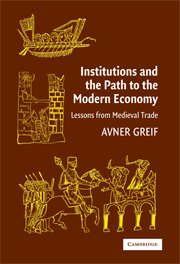Book contents
- Frontmatter
- Contents
- Abbreviations
- Preface
- I Preliminaries
- II Institutions as Systems in Equilibria
- III Institutional Dynamics as a Historical Process
- IV The Empirical Method of Comparative and Historical Institutional Analysis
- 10 The Institutional Foundations of Impersonal Exchange
- 11 Interactive, Context-Specific Analysis
- V Concluding Comments
- Appendixes
- References
- Index
- POLITICAL ECONOMY OF INSTITUTIONS AND DECISIONS
11 - Interactive, Context-Specific Analysis
Published online by Cambridge University Press: 05 September 2012
- Frontmatter
- Contents
- Abbreviations
- Preface
- I Preliminaries
- II Institutions as Systems in Equilibria
- III Institutional Dynamics as a Historical Process
- IV The Empirical Method of Comparative and Historical Institutional Analysis
- 10 The Institutional Foundations of Impersonal Exchange
- 11 Interactive, Context-Specific Analysis
- V Concluding Comments
- Appendixes
- References
- Index
- POLITICAL ECONOMY OF INSTITUTIONS AND DECISIONS
Summary
To identify and understand the operation of the community responsibility system, the analysis in Chapter 10, like all of the empirical analyses in this book, used a particular case study method. Specifically, it employed a theoretically informed, case study method that extensively relied on contextual knowledge of the situation and its history, and context-specific modeling. This chapter first argues that this method usefully responds to the challenge that institutional analysis presents to the traditional empirical methods of the social sciences; it then presents this methodin detail.
The challenge that institutions present to the traditional empirical methods of social science has two sources. First, although institutions are not random – those that fulfill a particular function or interest respond to the same forces and considerations – they are inherently indeterminate, historically contingent, and context-specific. We don't have a theory of institutions to guide their empirical analysis, and what we know about them suggests that seeking such a theory is likely to be a futile exercise (section 11.1). Second, we cannot generally study institutions by considering only their observable features (section 11.2).
The method presented here responds to institutions' inherent indeterminacy, their context-specificity, and the need to coexamine institutions' observable and unobservable components. This method interactively combines theory, contextual knowledge of the situation and itshistory, and context-specific modeling. A case study approach such as this is promising for several other reasons. Institutions' inherent indeterminacy and context-specificity imply that we often need to study an institution as a historically unique phenomenon.
- Type
- Chapter
- Information
- Institutions and the Path to the Modern EconomyLessons from Medieval Trade, pp. 350 - 376Publisher: Cambridge University PressPrint publication year: 2006



